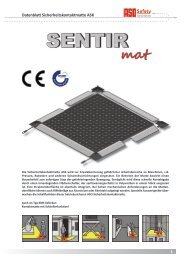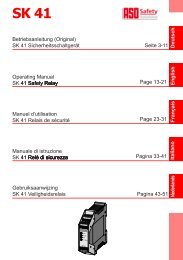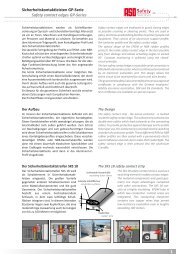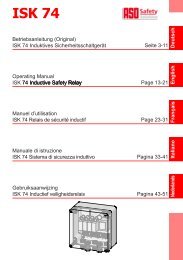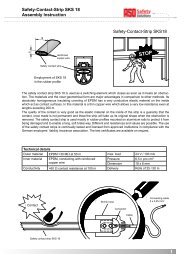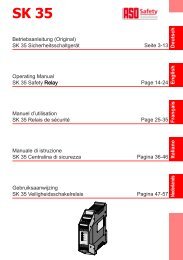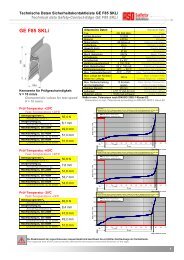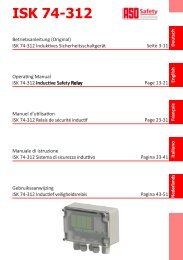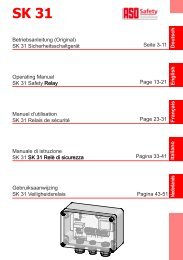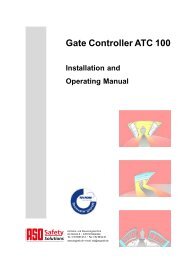ISK 77 / SPK 77 - ASO Safety
ISK 77 / SPK 77 - ASO Safety
ISK 77 / SPK 77 - ASO Safety
You also want an ePaper? Increase the reach of your titles
YUMPU automatically turns print PDFs into web optimized ePapers that Google loves.
English<br />
28<br />
<strong>ISK</strong> <strong>77</strong> / <strong>SPK</strong> <strong>77</strong> Inductive <strong>Safety</strong> Relay<br />
8.3 Connecting multiple sensors per sensor circuit (figure 1)<br />
One or more sensors can be connected to sensor input O or C. For this purpose, the individual<br />
sensors are connected in series according to figure 1.<br />
Up to five sensors may be connected in series, whereby the total cable length must not exceed 25 m.<br />
The length of one sensor ma�� be up to 25 m.<br />
Before connecting the sensors that are connected in series, it is recommended that the resistance<br />
value of the arrangement be measured.<br />
The resistance must be 8.2 kW ± 100 W when the SCE is inactive and must not exceed 500 W when<br />
it is active.<br />
O<br />
2<br />
<strong>ASO</strong> sensors must not be connected in parallel.<br />
Sensor 1<br />
9. Electrical commissioning<br />
2<br />
Sensor 2<br />
C<br />
Figure 1: Wiring of multiple sensors; in this example: safety contact edge<br />
Sensor "n"<br />
Connecting to the wrong terminals can destroy the switching unit.<br />
9.1 Prerequisites<br />
• When suppl��ing with 24 V AC/DC, the voltage must compl�� with the requirements for Safet�� Low<br />
Voltage (SELV).<br />
• All applied voltages must compl�� with the requirements for Safet�� Low Voltage (SELV). With<br />
variant E, the outputs are not galvanicall�� separated from the suppl�� voltage.<br />
• Cables installed outdoors or outside of the switching cabinet must be protected appropriatel��.<br />
9.2 Electrical connection<br />
• Connect 24 V suppl�� voltage to terminals B1 B2.<br />
• Connect stationar�� sensors to the SCE OPEN and SCE CLOSE connections.<br />
• Connect the safet�� circuit to be monitored to the appropriate connections for safet�� outputs Open<br />
and Close. The cables are to be laid so that it is impossible to bridge the safet�� contacts, e.g. b��<br />
a short circuit between the two connection wires (particularl�� with variant R).<br />
Following successful commissioning, safet�� outputs are active. Actuation of a sensor causes the<br />
respective safet�� output to switch to the inactive state.<br />
Even while the safet�� outputs are being activated, their abilit�� to turn off is constantl�� tested (not with<br />
variant R). For this purpose, the semiconductor output is switched off several times per second for<br />
less than 1 ms and the response at the output monitored. If the voltage at the output does not switch<br />
to the shut-down state, the device deactivates permanentl�� and can onl�� be reset b�� switching the<br />
voltage suppl�� off and back on again. This permanent deactivation also occurs if, depending on the<br />
t��pe of activation, the voltage cannot break down (e.g. b�� means of capacitive elements).<br />
2<br />
2



